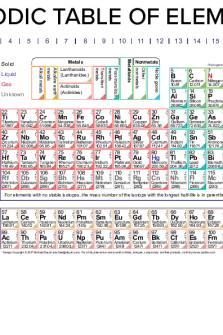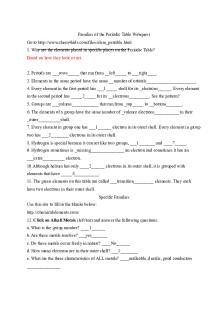Summary of Trends in the Periodic Table PDF

| Title | Summary of Trends in the Periodic Table |
|---|---|
| Author | Natalie Johnston |
| Course | Organic Chemistry I |
| Institution | The University of Western Ontario |
| Pages | 1 |
| File Size | 93.9 KB |
| File Type | |
| Total Downloads | 72 |
| Total Views | 144 |
Summary
Personal notes summarizing trends in the periodic table...
Description
Summary of Trends in the Periodic Table Below is a summary of factors that affect periodic trends or the electrostatic force. These factors really affect only one “thing” about the electrons in an atom, which is the electrostatic force on an electron (how hard electrons are being held onto). Factor 1: Orbit number, n Comparing elements above and below on the periodic table As n increases, the valence electrons are further from the nucleus Factor 2: Nuclear charge (number of protons), Z Comparing elements left and right on the periodic table As Z increases (and the orbit number remains the same), there is a stronger electrostatic force Trends 1.
2. 3. 4.
5. 6.
Atomic radius: The atomic radius is defined as one-half the distance between the nuclei of identical atoms that are bonded together. Ionic Radius: The ionic radius is the distance between the nucleus and the electron in the outermost shell of an ion. Ionization Energy: The minimum energy required to remove an electron from an atom or ion in the gas phase. Metallic Character: Refers to the level of reactivity of a metal. Metallic bonding accounts for many physical properties of metals, such as strength, malleability, ductility, thermal and electrical conductivity, opacity, and luster. Electron Affinity: The electron affinity of an atom or molecule is defined as the amount of energy released when an electron is attached to a neutral atom or molecule in the gaseous state to form a negative ion. The energy released when an atom gains one electron. Non-metallic Character: Relates to the tendency to accept electrons during chemical reactions. Electronegativity: A measure of the tendency of an atom to attract a bonding pair of electrons. It is not an actually physical property that can be measured – it has been determined/”made up” by scientists. As you move down the periodic table: Atomic radius increases Ionization energy decreases Metallic character increases Electron affinity decreases Non-metallic character decreases
As you move right across the periodic table:
Atomic radius decreases Ionization energy increases Metallic character decreases Electron affinity increases Non-metallic character increases...
Similar Free PDFs

Periodic Table Summary Notes
- 11 Pages

Periodic Table of the Elements
- 1 Pages

Periodic Trends
- 4 Pages

The Periodic Table
- 8 Pages

Navigating the periodic table
- 36 Pages

Copy of Periodic Trends Analysis
- 3 Pages

History of Periodic Table
- 1 Pages

Periodic table
- 2 Pages

Graphing Periodic Trends
- 3 Pages

Periodic-table
- 1 Pages

Periodic Trends - Notes
- 2 Pages
Popular Institutions
- Tinajero National High School - Annex
- Politeknik Caltex Riau
- Yokohama City University
- SGT University
- University of Al-Qadisiyah
- Divine Word College of Vigan
- Techniek College Rotterdam
- Universidade de Santiago
- Universiti Teknologi MARA Cawangan Johor Kampus Pasir Gudang
- Poltekkes Kemenkes Yogyakarta
- Baguio City National High School
- Colegio san marcos
- preparatoria uno
- Centro de Bachillerato Tecnológico Industrial y de Servicios No. 107
- Dalian Maritime University
- Quang Trung Secondary School
- Colegio Tecnológico en Informática
- Corporación Regional de Educación Superior
- Grupo CEDVA
- Dar Al Uloom University
- Centro de Estudios Preuniversitarios de la Universidad Nacional de Ingeniería
- 上智大学
- Aakash International School, Nuna Majara
- San Felipe Neri Catholic School
- Kang Chiao International School - New Taipei City
- Misamis Occidental National High School
- Institución Educativa Escuela Normal Juan Ladrilleros
- Kolehiyo ng Pantukan
- Batanes State College
- Instituto Continental
- Sekolah Menengah Kejuruan Kesehatan Kaltara (Tarakan)
- Colegio de La Inmaculada Concepcion - Cebu




